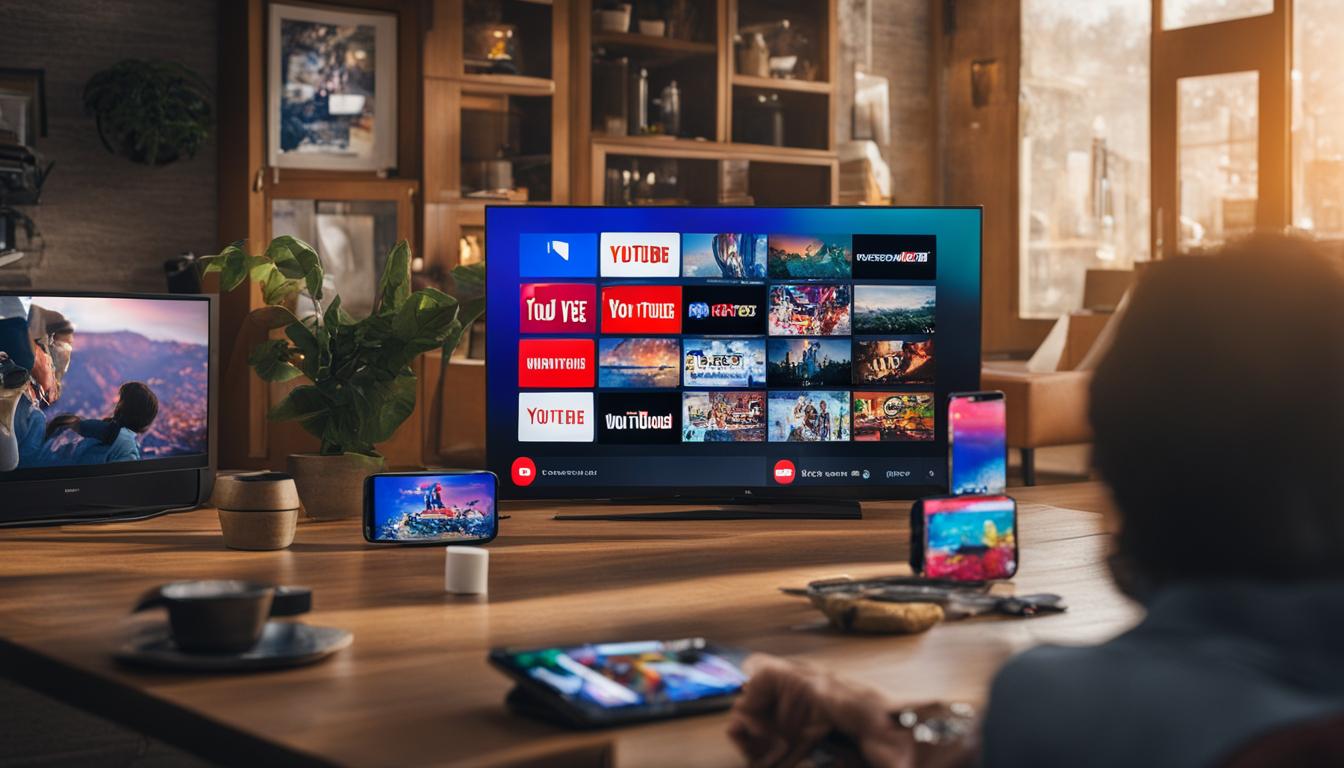
Are you wondering why there seems to be an increasing number of ads on YouTube? You’re not alone! In this section, we’ll explore the factors that contribute to the ad frequency on YouTube and explain why you may be encountering more ads than before.
YouTube, being a free platform, relies on advertising as its primary source of revenue. Advertisements help support content creators and enable YouTube to continue providing access to a vast library of videos. But why does YouTube show so many ads? Let’s delve into the reasons:
Key Takeaways:
- YouTube displays ads based on factors like your viewing history, Google Account information, online activity, and websites you visit.
- The goal is to improve ad relevancy and provide you with personalized content.
- You have control over the ads you see through Ad Settings and can provide feedback on inappropriate ads.
- YouTube Premium is a paid membership option that offers an ad-free video experience.
- Understanding YouTube’s advertising model and factors influencing ad frequency can help you manage and improve your overall ad experience.
Understanding YouTube’s Advertising Model
YouTube is a platform that relies heavily on advertising to generate revenue. The advertisements are displayed before, during, or after videos, allowing YouTube to monetize its vast user base. This advertising model has proven to be highly successful, as it not only benefits YouTube but also provides content creators with a share of the ad revenue.
So how does YouTube make money through ads? Advertisers choose to run ads on YouTube because of its extensive reach and user engagement. YouTube offers various ad formats to cater to different advertising objectives. These formats include pre-roll ads, which play before the video starts; display ads, which appear alongside the video; and sponsored cards, which display relevant product information during the video.
The revenue generated from these ads is then shared with content creators. The amount earned by creators depends on factors such as the number of ad impressions and the level of audience engagement. This monetization system incentivizes creators to produce high-quality content and build a loyal audience.
| Advantages of YouTube’s Advertising Model | Disadvantages of YouTube’s Advertising Model |
|---|---|
|
|
While YouTube’s advertising model has its advantages and disadvantages, it remains an essential component of the platform’s success. It allows YouTube to continue providing a free service to users while supporting content creators financially. However, if you prefer an ad-free experience on YouTube, you can opt for YouTube Premium, a paid membership that offers uninterrupted viewing.
The Future of YouTube Advertising
As YouTube continues to evolve, so does its advertising model. The platform is constantly exploring new ways to improve ad relevance and user experience. This includes advancements in targeting capabilities, ad personalization, and user feedback mechanisms. YouTube is also investing in alternative revenue streams, such as subscriptions and merchandise sales, to provide additional income opportunities for creators.
Factors Influencing Ad Frequency on YouTube
When it comes to ad frequency on YouTube, there are several factors at play that determine how often you encounter ads while watching videos. These factors include YouTube’s ad targeting capabilities, the different types of ad formats available, and the revenue share between YouTube and content creators.
YouTube Ad Targeting
YouTube utilizes various data points to target ads to its users. The content you’re watching, your Google Account information, and your online activity all contribute to the ads you see on the platform. This targeted advertising approach is aimed at delivering relevant and personalized ads to enhance your overall viewing experience.
YouTube Ad Formats
YouTube offers a range of ad formats that can impact ad frequency. Skippable ads, for example, allow users to skip the advertisement after a few seconds, providing a less intrusive viewing experience. On the other hand, non-skippable ads require users to watch the full ad, which may result in higher ad frequency. Understanding different ad formats can help users better navigate and manage their ad experience on YouTube.
YouTube Ad Revenue Share
For content creators, ad revenue share is an essential part of monetizing their videos on YouTube. Creators receive a percentage of the revenue generated from ads displayed on their videos. This incentivizes creators to monetize their content and can impact the frequency of ads in their videos. Higher ad frequency may translate to increased revenue potential for both creators and YouTube.
| Factors Influencing Ad Frequency on YouTube | Impact on Ad Frequency |
|---|---|
| YouTube Ad Targeting | Personalized ads based on user data |
| YouTube Ad Formats | Different formats offer varying ad frequency |
| YouTube Ad Revenue Share | Increased revenue potential may lead to higher ad frequency |
Understanding the factors influencing ad frequency on YouTube can help users better manage their ad experience on the platform. By leveraging Ad Settings and taking advantage of YouTube’s options to report inappropriate ads, users can have more control over the ads they encounter. Additionally, content creators can monetize their videos and benefit from the ad revenue share, providing them with an opportunity to enhance their content and engage with their audience.

Managing and Improving Your Ad Experience
Controlling the ads you see on YouTube can greatly enhance your viewing experience. YouTube understands that not all ads may be relevant or appealing to you, which is why they provide tools to personalize and manage your ad experience.
One way to control your ad experience is through the Ad Settings. By accessing your Ad Settings, you can adjust the types of ads you see, limit ad personalization, and even block specific advertisers. This allows you to tailor your ad experience to better align with your interests and preferences.
Additionally, if you come across an ad that you find inappropriate or offensive, you have the option to report it. YouTube takes user feedback seriously and reviews reported ads to ensure they comply with their policies. This helps create a safer and more enjoyable ad environment for all users.
Controlling Your Ad Settings
YouTube provides a range of options in your Ad Settings that can help you fine-tune your ad experience:
- Ad Personalization: You can choose to turn off ad personalization, which means that ads will no longer be based on your interests and browsing behavior.
- Ad Topics: You can select or deselect specific topics that you are interested in or wish to exclude from your ad experience.
- Blocked Ads: You have the ability to block ads from specific advertisers or industries that you find irrelevant or annoying.
By utilizing these features, you can take control of the ads you see on YouTube and create a more enjoyable viewing experience.
Reporting Inappropriate Ads
If you encounter an ad that violates YouTube’s policies, you can report it for review. To report an ad, simply click on the small “i” icon in the corner of the ad and select the appropriate reporting option. YouTube will then investigate the ad and take appropriate action if necessary.
Reporting inappropriate ads not only helps improve your own ad experience but also contributes to the overall quality of ads on YouTube. Your feedback can assist YouTube in identifying and removing ads that may be offensive, misleading, or in violation of their policies.

| Advantages of Managing Your Ad Experience | Disadvantages of Managing Your Ad Experience |
|---|---|
|
|
Alternatives to Dealing with YouTube Ads
While YouTube offers a wide range of content and entertainment, sometimes the ads can be a bit overwhelming. However, there are a few alternatives to dealing with these ads that you may find helpful. Let’s explore some options:
1. YouTube Premium
One of the most well-known solutions to enjoy an ad-free YouTube experience is by subscribing to YouTube Premium. For a monthly fee, you can watch videos without interruptions from ads. Additionally, YouTube Premium offers other benefits, such as access to YouTube Originals and the ability to download videos for offline viewing. It’s a great option if you’re willing to invest in a seamless viewing experience.
2. Ad Blockers
If you prefer not to spend money on a subscription, you can consider using ad blockers for YouTube. Ad blockers are browser extensions or software that help block ads across various websites, including YouTube. They work by detecting and preventing ad scripts from loading, effectively minimizing or eliminating ads altogether. However, it’s important to note that YouTube has implemented measures to detect and limit the usage of ad blockers, so their effectiveness may be limited.
3. YouTube Clones
Another alternative to dealing with YouTube ads is exploring alternative video-streaming platforms often referred to as “YouTube clones.” These platforms aim to provide an ad-free streaming experience similar to YouTube. However, it’s essential to exercise caution when using these clones as they may not always be reliable or easily accessible. Additionally, they may not offer the same level of content variety or features as the official YouTube platform. It’s important to do your research and choose a reputable alternative if you decide to go down this route.
Overall, there are alternatives available to help you minimize or eliminate ads while enjoying YouTube. Whether you opt for YouTube Premium, ad blockers, or explore YouTube clones, it’s essential to find a solution that suits your preferences and ensures a pleasant viewing experience.
| Alternatives | Pros | Cons |
|---|---|---|
| YouTube Premium | – Ad-free experience – Access to YouTube Originals – Offline viewing |
– Monthly subscription fee |
| Ad Blockers | – Blocks ads across websites – Free to use |
– YouTube has measures to limit their effectiveness |
| YouTube Clones | – Ad-free streaming – Alternative video platforms |
– May not be reliable or accessible – Limited content and features |
Conclusion
In conclusion, YouTube’s advertising model heavily relies on ads to generate revenue for content creators and sustain the platform. While the increasing number of ads may seem obtrusive at times, there are options available to enjoy an ad-free experience.
A great solution to avoid ads on YouTube is YouTube Premium. With a paid membership, you can enjoy uninterrupted video streaming without any advertisements. It’s an excellent choice for those who want to enhance their viewing experience and manage their ad exposure.
For those who prefer to stick with the free version of YouTube, you can still manage and customize your ad experience. Utilize the Ad Settings to control the type of ads you see and provide feedback on inappropriate advertisements. This way, you can have a more personalized and relevant ad experience.
Lastly, while alternative methods like using ad blockers or exploring YouTube clones may temporarily alleviate ad-related frustrations, they come with their own limitations and risks. These alternatives may not always be reliable or accessible, making YouTube Premium or managing ads through Ad Settings the recommended solutions for a seamless and enjoyable YouTube experience.
FAQ
Why are there so many ads on YouTube?
YouTube’s main revenue source is advertising, so ads are displayed before, during, or after videos to support content creators and provide revenue for the platform.
How does YouTube make money?
YouTube generates revenue through advertisements. Advertisers choose to run ads on YouTube to reach its large user base, and content creators earn a share of the ad revenue based on factors like ad impressions and engagement.
What factors influence the frequency of ads on YouTube?
Ad frequency on YouTube can be influenced by factors such as the content you’re watching, your Google Account information, and your online activity. YouTube offers different ad formats, including skippable and non-skippable ads.
Can I control the ads I see on YouTube?
Yes, you can control the ads you see by adjusting your Ad Settings. YouTube also provides options to rate ads, report inappropriate ads, and customize your ad experience. If you find an ad that violates YouTube’s policies, you can report it for review.
Are there alternatives to dealing with YouTube ads?
YouTube Premium offers an ad-free experience for those who prefer not to see ads. Ad blockers can also be used, although YouTube has measures in place to detect and limit their usage. Some alternative video-streaming programs, known as YouTube clones, provide ad-free streaming experiences, but they may not always be reliable or accessible.






